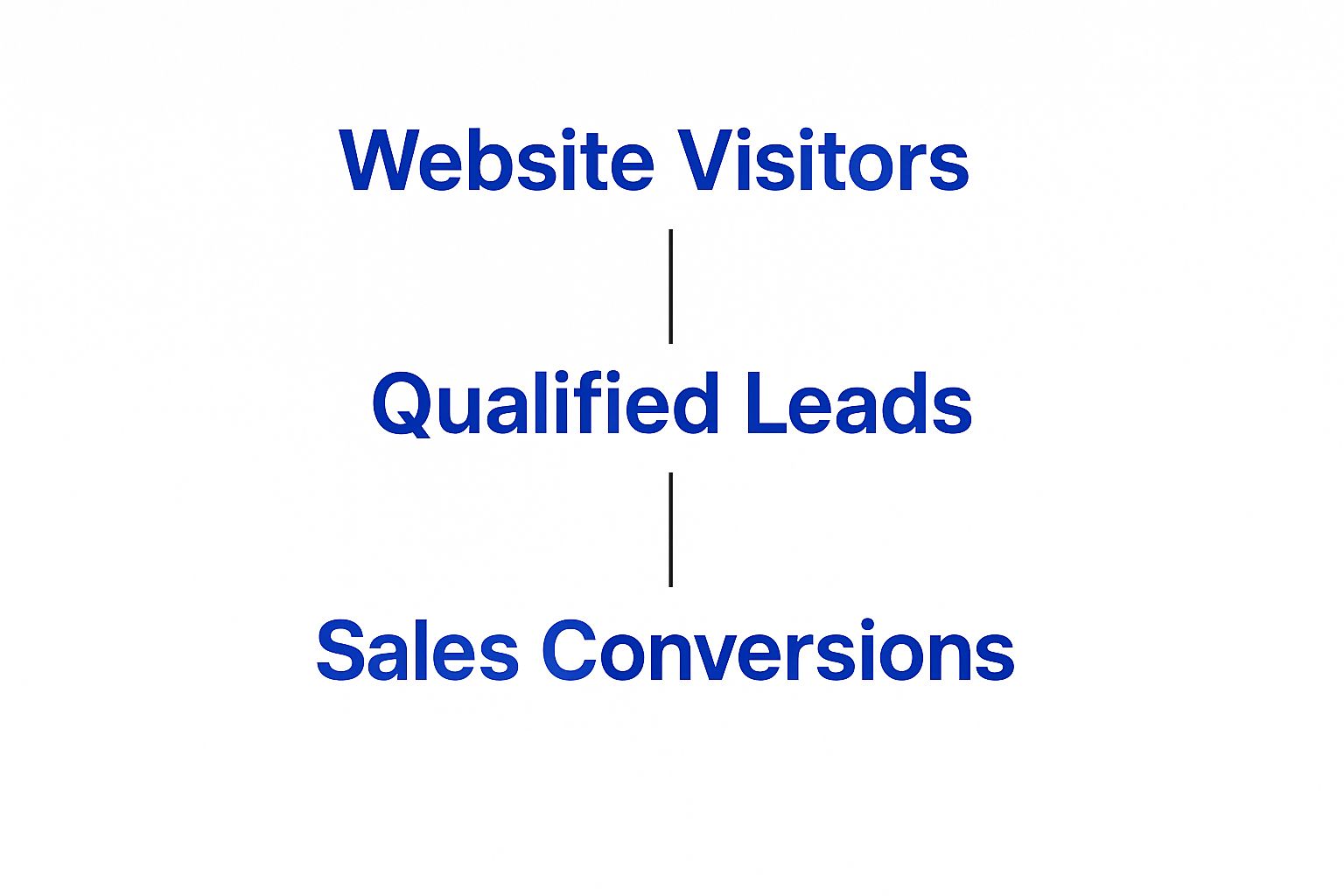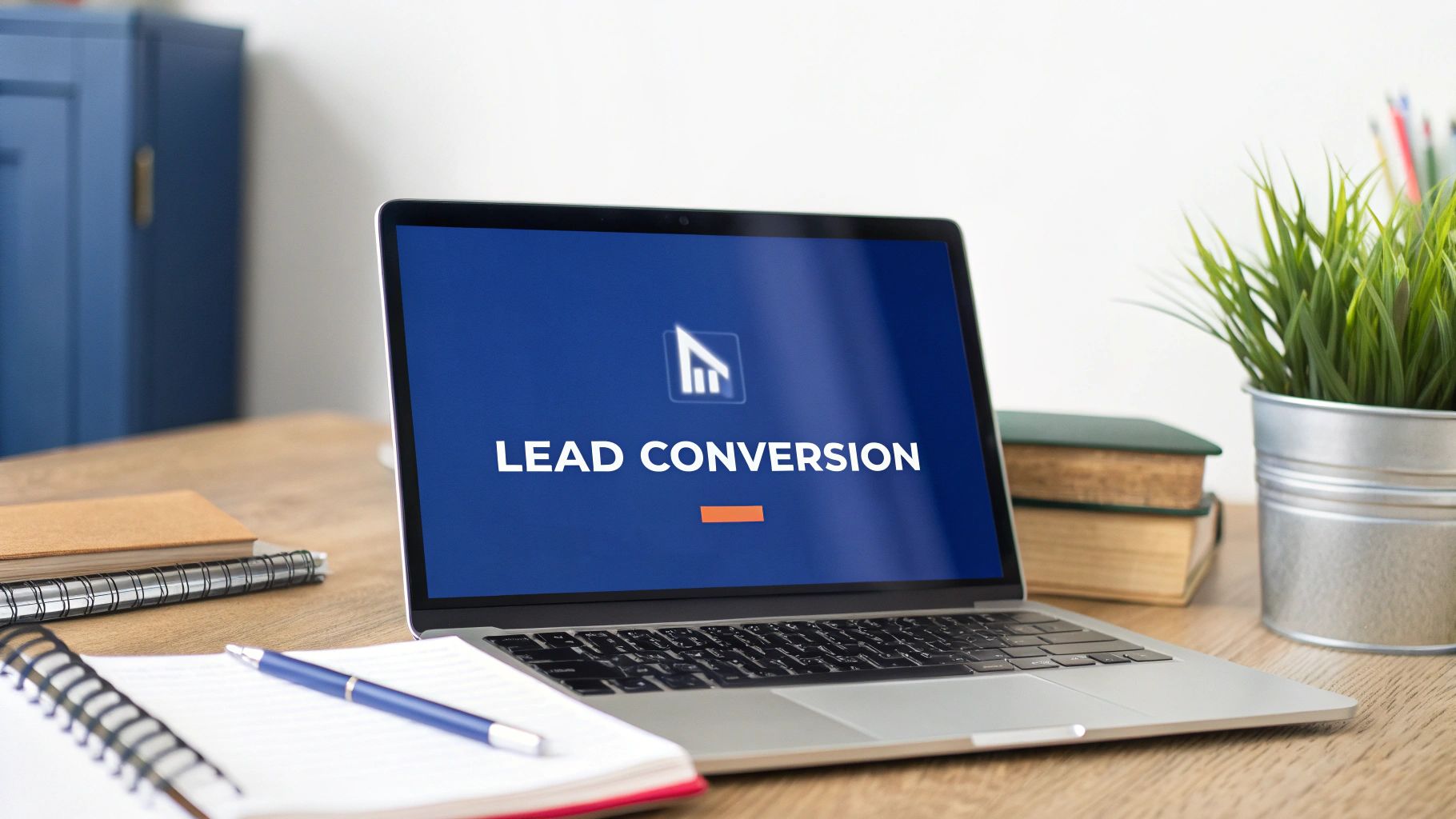In the commercial insurance space, a refined lead generation process is the engine that drives sustainable growth. It’s about shifting focus from chasing *volume* to pursuing *value*, ensuring every marketing dollar and sales hour is invested in opportunities with real, bottom-line potential.
What Is the Modern Lead Generation Process
The modern lead generation process in commercial insurance is a systematic approach to identifying and engaging businesses that align with your risk appetite and growth strategy. It’s not just about collecting contact info; it’s about building a predictable pipeline of ideal clients.
This strategic lifecycle is broken down into clear, actionable stages, ensuring your team's efforts are focused and effective. One of the most powerful modern approaches is built around inbound marketing lead generation, a method centered on attracting customers by providing genuine value.
For underwriters, brokers, and risk managers, mastering this process provides a significant competitive advantage. It boils down to a few key activities:
- Identifying Ideal Prospects: Pinpointing companies that fit your specific risk profiles, industry focus, and revenue targets.
- Enriching Data: Transforming a company name into a rich profile with firmographics, key decision-maker contacts, and critical risk indicators.
- Qualifying Opportunities: Methodically scoring leads to separate high-potential accounts from those unlikely to convert.
- Nurturing Relationships: Building credibility and trust with prospects over time through consistent, valuable engagement—not just sales pitches.
This diagram shows the fundamental flow, from initial contact to final sale.

Image
The visual drives home the critical filtering that happens at each stage. It's a funnel for a reason—only the most promising opportunities should advance to the final conversion phase.
The Four Core Stages of a Lead Generation Process
The entire lifecycle can be understood in four distinct stages. Each has a clear goal and a set of activities designed to move a prospect smoothly to the next phase.
| Stage | Primary Goal | Key Activities |
|---|---|---|
| 1. Prospect Identification | Build a targeted list of potential clients who match your ideal customer profile (ICP). | Market research, data mining, using business intelligence platforms, identifying industry segments. |
| 2. Data Enrichment & Nurturing | Transform basic contact info into a detailed profile and build initial trust. | Appending firmographic data, identifying key decision-makers, launching targeted content marketing, email nurturing sequences. |
| 3. Lead Qualification | Score and prioritize leads to determine which are sales-ready. | Implementing lead scoring models (e.g., BANT), conducting initial discovery calls, separating Marketing Qualified Leads (MQLs) from Sales Qualified Leads (SQLs). |
| 4. Follow-Up & Performance Analysis | Engage qualified leads effectively and continuously optimize the process. | Timely sales outreach, scheduling meetings, tracking conversion rates, analyzing channel performance, refining the ICP based on results. |
Mastering these four stages turns lead generation from a guessing game into a repeatable, scalable process that consistently fuels your sales pipeline.
Lead generation remains a top concern for marketers, with 50% calling it a top priority. On average, organizations generate 1,877 leads per month, with an average cost per lead of $198.44. These numbers highlight the importance of an efficient system.
A well-oiled process is essential for maximizing this investment. Modern tools can sharpen your strategy, and you can learn more about how a business intelligence platform can help at https://insurtech.bpcorp.eu/pages/lead-gen.
Laying the Foundation: Finding Your Ideal Prospects

Image
The success of your lead generation process is determined by one factor: identifying the right prospects from the very beginning. A flawed start builds a pipeline full of dead ends, wasted resources, and dismal conversion rates.
Moving past generic, purchased lists to pinpoint ideal clients with precision is a necessity.
Consider it like building a custom risk model. You would never use generic, outdated data to assess a complex commercial property risk, and the same standard should apply to building your prospect list. The goal is to create a highly targeted group of companies that align with your strategic goals. This is where a modern business intelligence platform becomes your most valuable asset.
This approach allows your team to cut through superficial data points and apply deep, meaningful filters. You can segment your market with a level of detail previously unattainable, creating a solid foundation for every subsequent step.
Defining Your Ideal Customer Profile
Your Ideal Customer Profile (ICP) is the blueprint for your entire prospecting effort. It is a dynamic document that describes the perfect client for your specific insurance products or services. A strong ICP goes beyond basic industry codes.
For commercial insurers, an effective ICP must include specific criteria that tie directly to your risk appetite and profitability targets.
- Firmographics: Filter by annual revenue, company size, number of locations, and years in business to zero in on your target market segment.
- Geographic Focus: Pinpoint businesses operating in specific states, counties, or even ZIP codes that fit your coverage areas or risk concentration strategy.
- Industry Specialization: Target the specific NAICS codes that represent your most profitable verticals, whether that's manufacturing, logistics, or commercial real estate.
- Technographics: Identify companies using specific technologies (like certain e-commerce platforms or cloud providers) that signal a clear need for cyber liability coverage.
An ICP is not a static document. It must be refined constantly based on which clients prove to be the most profitable and have the highest retention. This feedback loop is what makes your targeting sharper and more accurate over time.
From Profile to Prospect List
Once you have a clear ICP, the next step is to generate an actionable list of prospects. A business intelligence platform transforms this from a manual research project into an efficient, data-driven operation.
For example, a broker specializing in commercial property insurance for coastal businesses can instantly filter for companies with high-value assets located in hurricane-prone regions.
This level of precision ensures that your underwriting and sales teams are focused exclusively on high-potential opportunities from the start. Building this strong foundation is a non-negotiable part of a successful strategy for insurance lead generation. The result is a higher quality pipeline and a more efficient sales cycle.
Turning Raw Data into Actionable Intelligence
A list of company names generated from your ICP is just a starting point—a list of possibilities, not opportunities. The real leverage in a modern lead generation process comes from enriching that raw data, turning a simple name into a detailed profile that provides a competitive edge.
This enrichment process transforms a basic prospect list into a rich dataset filled with actionable insights. A raw list is a black-and-white photograph; enriched data is a full-color, 4K video. One gives you a static picture; the other shows you what is actually happening.
For commercial insurance professionals, this means being armed with critical information before the first contact. Underwriters can pre-assess risk exposures. Brokers can craft a pitch that speaks directly to a prospect’s known challenges.
Key Data Points for Enrichment
To make data valuable, the enrichment must be specific. It’s not just about verifying a phone number. The goal is to build a complete picture of the prospect’s operational reality, focusing on details that inform risk assessment and sales strategy.
You are looking for three core types of data:
- Firmographics: This is the foundational data, including annual revenue, employee count, number of physical locations, and years in business. This data confirms the prospect fits your target size and stability profile.
- Technographics: This provides a window into the technology a company uses. Knowing a prospect runs on specific cloud services, payment gateways, or SaaS platforms can signal a clear need for cyber liability or E&O coverage.
- Trigger Events: These are time-sensitive signals of an immediate insurance need. Events like a new funding round, a recent merger or acquisition, key executive hires, or the opening of a new facility almost always force a review of existing policies.
An underwriter who knows a company just acquired a competitor can proactively address the combined entity’s new risk profile. A broker who sees a prospect just hired a new CFO can tailor their outreach around financial risk management. This is the power of enriched data in action.
Attempting to do this manually is not scalable. A robust business intelligence platform can append these data points to your prospect list almost instantly, ensuring your teams are always working with the most current, relevant information. This level of insight is fundamental to making informed decisions, a concept we break down further in our guide to real-time data analytics.
By turning raw data into actionable intelligence, you equip your team to engage prospects with precision, relevance, and perfect timing.
Qualifying Leads to Maximize Your ROI

Image
You've built an enriched list of prospects. The next step—qualification—is where real value is created or lost.
Chasing every lead is a direct path to a bloated pipeline, wasted resources, and a burnt-out sales team. Not all leads are created equal. Qualification is the critical filter that separates high-potential opportunities from time-consuming dead ends.
For commercial insurance professionals, this is not a simple "Are you interested?" checkbox. It's a deeper analysis of a prospect's risk maturity, genuine insurable interest, and readiness for a serious conversation.
The goal is to ensure your expert sales and underwriting teams spend their time on deals that have a realistic chance of closing. Getting this right has a dramatic impact on ROI, resulting in less time on dead-end calls and more time closing high-value policies.
Adapting Qualification Frameworks for Insurance
Classic sales frameworks like BANT and MEDDIC are a starting point, but they require significant adaptation for the commercial insurance sector. Brokers and underwriters must customize them to get to the heart of risk and need.
Here’s what a modified, insurance-centric approach could look like:
- Budget: Does this business have a realistic budget allocated for its insurance needs? This question confirms financial viability from day one.
- Authority: Are you speaking with the person who can sign the policy—the risk manager, CFO, or owner? Or are you speaking to an influencer?
- Need: What specific operational risks or compliance issues are driving their need for coverage? Is there a clear, urgent problem you can solve?
- Timeline: Is a policy renewal approaching? A new project launching? What is the trigger event that puts a deadline on this decision?
For an underwriter, a critical qualification question is: "Does this prospect’s risk profile align with our current appetite?" Answering that early on can save weeks of work on a deal that was never going to be approved.
By using a systematic process like this, you create a clear distinction between a simple Marketing Qualified Lead (MQL) and a true Sales Qualified Lead (SQL) that is ready for a serious conversation.
The market for these lead generation efforts is projected to hit $15.55 billion by 2031. With 53% of marketers already allocating over half their budget to lead generation, smart qualification is how you justify that spend. To ensure every dollar counts, you must know what it costs to land a new client; learn how to calculate customer acquisition cost. For a deeper dive into tactics specific to our industry, our guide on how to generate insurance leads breaks it all down.
From Qualified Lead to Loyal Partner

Image
A qualified lead is not a guaranteed sale; it is the start of a conversation. In commercial insurance, where decisions are complex and sales cycles can be long, the nurturing phase is where the real work happens. It is how you turn a promising contact into a high-value, long-term partner.
The focus shifts from selling to advising. Your goal is to build credibility and stay top-of-mind by delivering value long before a policy is on the table. You are no longer just a vendor; you are becoming an indispensable strategic advisor.
Build Credibility by Delivering Consistent Value
Effective nurturing is not about relentless follow-ups. It is about demonstrating your expertise in a way that helps a risk manager or CFO perform their job better. This is how you build trust, one interaction at a time.
Here are practical nurturing tactics that work in commercial insurance:
- Share Relevant Reports: Send a prospect a detailed risk management report that is specific to their industry or geographic location.
- Offer Timely Insights: When a new regulation is passed or a climate event impacts their region, send a brief analysis of how it could affect their operations.
- Provide Educational Content: Distribute case studies or whitepapers that show exactly how you've solved similar challenges for other businesses in their sector.
This approach ensures that when a prospect’s need becomes urgent—whether due to a renewal date or a sudden business change—your firm is the first one they call. For a deeper look at how to attract clients with valuable content, check out our guide on inbound marketing for lead generation.
Use Professional Networks to Build Real Relationships
In B2B insurance, your network is your net worth. Digital platforms now offer powerful ways to build and maintain these critical connections at scale. LinkedIn, in particular, has become an essential tool for building professional relationships and is a core part of any modern nurturing strategy.
LinkedIn is a dominant force in B2B. Research shows that 53% of B2B marketers now depend on LinkedIn to find prospects and get contact information. With over a billion users, its reach for connecting with key decision-makers is unmatched. You can find more insights on the role of LinkedIn in B2B marketing over on sopro.io.
The goal is not to send generic connection requests. It is about engaging thoughtfully with a prospect's content, sharing articles that will resonate with their business challenges, and using the platform to build a foundation of professional respect *before* you start a sales conversation.
Ultimately, a successful nurturing process is a marathon, not a sprint. By consistently delivering value and building authentic professional relationships, you transform hard-won qualified leads into loyal, long-term clients who see your firm as a true partner in managing their risk.
Measuring and Optimizing Your Growth Engine
A world-class lead generation process is not a static checklist. It is a dynamic system that requires constant attention—measuring, tweaking, and refining. To scale growth, you must look past superficial vanity metrics and focus on the key performance indicators (KPIs) that directly impact your bottom line.
This data-driven mindset turns a series of disconnected marketing activities into a predictable engine for business growth. It demands a commitment to tracking what works (and what doesn't) at every stage of the funnel.
For commercial insurance professionals, this means focusing on the numbers that reveal the health and efficiency of your pipeline. Tracking these figures provides the clarity to make smart adjustments, ensuring your time and money are always allocated to the most profitable channels.
Core Metrics for Insurance Professionals
To steer your lead generation strategy, focus on a handful of business-critical KPIs that give a clear view of your operational efficiency and return on investment.
- Lead-to-Opportunity Rate: What percentage of your leads are qualified and accepted by your sales or underwriting team? This is a direct reflection of your targeting accuracy. A low number here indicates a problem.
- Cost Per Acquisition (CPA): How much does it cost to acquire one new policyholder? This is the ultimate measure of your financial efficiency.
- Pipeline Velocity: How quickly do prospects move from the first conversation to a closed deal? A faster velocity means a healthier sales process and more accurate forecasting.
A low Lead-to-Opportunity Rate is a major red flag. It almost always points to a disconnect between your marketing message and what your sales team is seeing, or it means your Ideal Customer Profile needs an urgent revision.
When you create a tight feedback loop between your sales, underwriting, and marketing teams, you can use these insights to improve continuously. If leads from a specific industry consistently fail to convert, that is not a failure—it's data. Use it to sharpen your qualification criteria. This cycle of continuous optimization is what separates a good process from a great one.
Answering Your Top Questions
Let's address some of the most common questions from decision-makers trying to sharpen their commercial insurance lead generation.
What Is the Most Important Stage of the Process?
All stages are important, but Identification is the most critical. Everything downstream depends on it.
If you target the wrong prospects from the start, every dollar and minute spent on data enrichment, qualification, and follow-up is wasted. A clear Ideal Customer Profile (ICP) is not just a "nice-to-have"; it's the foundation of your entire lead generation engine. If this is wrong, nothing else can fix it.
How Can a Business Intelligence Platform Improve Our Process?
A business intelligence platform automates and strengthens nearly every stage of your funnel.
Instead of guessing, you can identify ideal prospects with precision using advanced filters. You can enrich that basic data with firmographic and technographic details that provide real context. Most importantly, it can flag trigger events—like a nearby weather catastrophe—that signal a company has an immediate need for new or better coverage. It replaces manual effort and guesswork with data-driven accuracy, giving your team a significant advantage.
How Do We Measure the ROI of Our Lead Generation Efforts?
To get a true handle on ROI, you need to track two things: the total cost of your lead generation activities (software, ad spend, salaries) and the total lifetime value (LTV) of the clients you acquire.
Stop obsessing over lead volume. Instead, zero in on the metrics that drive profit: Cost Per Acquisition (CPA), conversion rates between each stage, and the total value of policies closed from your efforts. That is what provides a true picture of financial performance.
---
Ready to turn climate events into high-intent commercial insurance opportunities? Insurtech.bpcorp.eu provides a real-time business intelligence platform that delivers validated, criteria-matched leads directly to your pipeline. Stop guessing and start engaging with businesses at their moment of greatest need. Discover how it works at https://insurtech.bpcorp.eu.